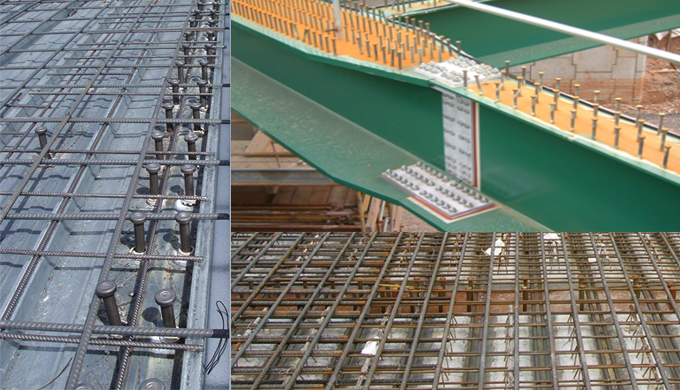
Role of Shear Connector in Composite Structure
A Shear connector belongs to a steel projection to be applied on the top flange of steel composite bridge girders to transmit required shear among the steel girder and composite slab to facilitate composite action.
The headed stud is mostly recognized form of shear connector, or shear stud. Other forms of shear connector range from block and hoop, and channel connectors. Block and hoop, and channel connectors are mainly applied for transmission of large shear. These are good substitute to narrowly spaced shear studs.
Shear connectors are specifically created to offer static strength as well as for fatigue loading. The shear connection should be tested at ULS and at SLS limit states. Under the provision of Euro code design, the constraint at SLS is defined in section 6.8.1(3) of EN 1994-2. Relevant design codes are stated for design provisions. It restricts the extreme force under the characteristic combination of actions. The SLS limit is applicable to long distance bridges containing a high dead load component.
Shear flows are measured at supports, at mid-span, and at quarter points, with the intension of planning a shear flow profile along a girder. Shear Connectors or studs are placed to withstand shear at the relevant locations.
Standard sizes for shear studs, which are generally utilized in steel composite bridge decks and quickly obtainable from suppliers, are of heights (in mm) 125, 150, 175, 200, 250 and diameters (in mm) 16 19 22 25. Normally, a welding gun is used to connect the shear studs to the top flanges of girders. The stud is kept in the welding gun and an arc is attached between stud and the flange plate. Arc combines a section of both the stud and the plate in a pre-arranged time.
Benefits of Shear Studs:
The following are the benefits of shear studs over other forms of connectors.
? Set up and welding method is easy and quick;
? Offers least obstacle to the slab reinforcement;
? Facilitates more reasonable compaction of the concrete all over the connectors;
? Offers identical shear strength in all directions.
Prerequisites of Shear Connectors
? The lowest distance among the edge of a shear connector and the edge of a flange plate should be 25 mm
? The highest longitudinal spacing is described in EN 1994-2, clause 6.6.5.5(3), and is the lesser of 800 mm or 4 x concrete slab thickness
? When the plate is dependent on tensile stress or fatigue loading, diameter of the shear stud must not surpass one and a half times the plate thickness,
? Diameter of the shear stud must not surpass 2.5 times the plate thickness in other cases.
? Foundation of the head of shear stud should be minimum 30 mm above the bottom transverse reinforcement, so that it manages the height of the stud.
How to verify a Shear Connector - As per Euro Code, the following two quality tests are approved to guarantee the quality of the stud weld :-

Ref.: civildigital.com
Ring Test: Under the ring test, a hammer having weight 2 kg is used to hit the side of the head of the stud. After hitting, if a ringing tone is hear, it specifies good fusion. On the other hand, if a dull tone is heard, it specifies scarcity of fusion. All studs should be verified in this way through the welder or the welder?s mate.
Bend Test: Under bend test, a 6 kg hammer is used to laterally replace the head of a stud by roughly 1/4 of its height. The weld should then be examined for signs of cracking or scarcity of fusion. The designer should indicate the testing rate and it is generally 1 stud in 50.

